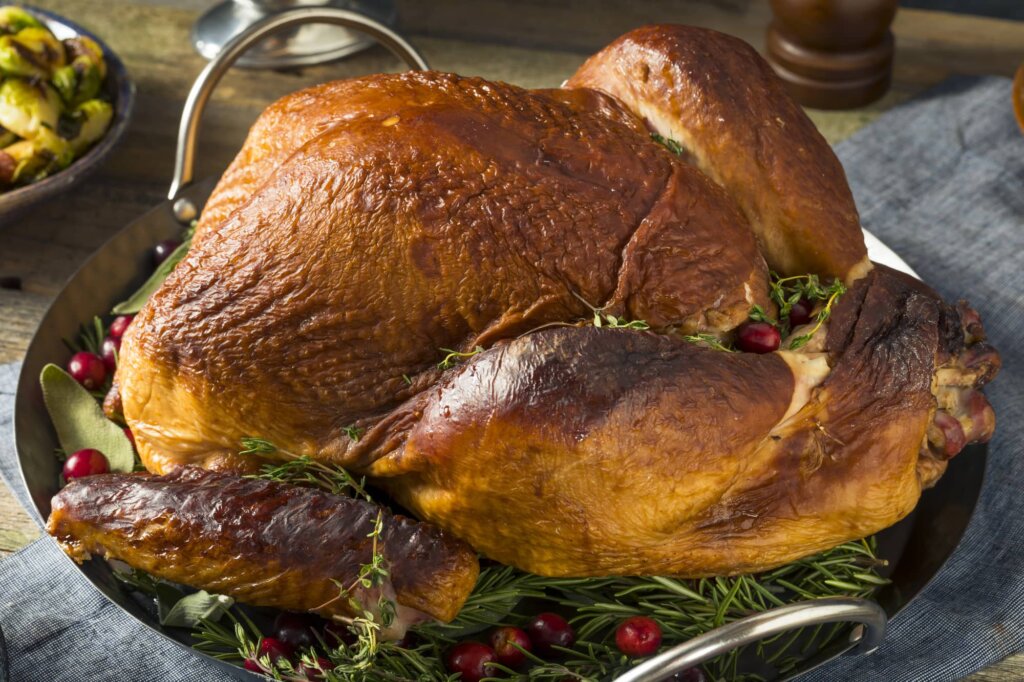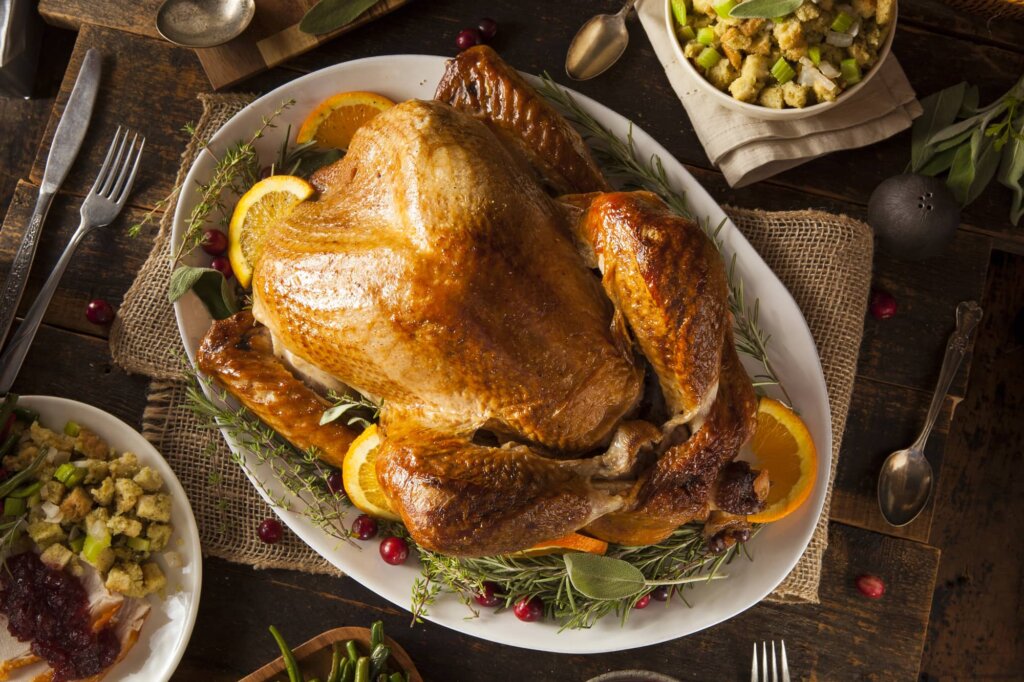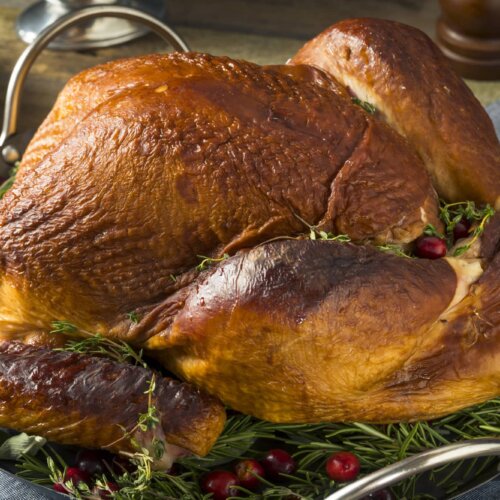
Smoked turkey is just as delish for holiday feasts as it is for backyard gatherings. Dress it up or dress it down; either way, you’ll have an exceptional star of the dinner plate that you’ll want to keep refueling with. In this guide, we’ll walk you through every step of the process of smoking a turkey, from selecting the best turkey to preparing it to smoking it to perfection.
Choosing Your Turkey
There are several factors to consider when shopping for a turkey to cook in your smoker.
The most important factor may be the size of your turkey. Generally, a 12 to 14-pound turkey is best, as larger turkeys may not cook evenly. You could end up with an undercooked inside while the outside gets too crispy and dry. Also, a larger bird might not fit in your smoker well, which could prevent you from closing the lid or door fully. If you need more meat than this size of turkey provides, consider cooking two smaller turkeys instead of one large one.
Next, be sure to use a thawed turkey rather than cooking the turkey from frozen. If you buy a frozen turkey, thaw it completely before cooking to ensure a thorough cook. This process can take a few days, so plan ahead.
Brining is another point to consider. Many store-bought turkeys are injected with a saline solution or pre-brined, which can affect how you prepare them for smoking. If the turkey is pre-brined, you won’t need to brine it yourself. For more control over flavor, buy a natural turkey with no added solutions so you can season, glaze, or brine it how you’d like.
Finally, look for a turkey with healthy-looking skin that fully covers the turkey, as torn skin can lead to dried-out spots while smoking. A moderate fat layer is also nice to have. The skin helps keep the meat moist during the smoking process, and the fat enhances flavor.
Preparing the Turkey for the Smoker
Start by ensuring your turkey is completely thawed if frozen. The safest method is to thaw it in the refrigerator, which can take several days, even for a smaller turkey.
Once thawed, remove the giblets and neck from the cavity and trim any excess skin or fat, especially around the neck and cavity. This helps prevent flare-ups in the smoker and keeps the turkey cooking evenly. Pat the turkey completely dry before brining or seasoning it.
While optional, you might consider trussing the turkey. Trussing involves tying the legs together with kitchen twine, which helps the bird cook more evenly by keeping the wings and legs close to the body, preventing them from overcooking before the rest of the turkey is done. It also gives the turkey a more uniform shape, making it easier to handle and present.
Finally, let your turkey sit at room temperature for about 60 minutes before you’re ready to smoke it. You can season it during this time.
Brine and Seasoning for Smoked Turkey
Brining keeps the turkey moist and flavorful. You can brine the turkey by soaking the turkey in a saltwater solution for 12 to 24 hours, which locks in moisture and enhances the taste. However, this step is completely optional (and unnecessary if you bought a pre-brined turkey), and you can choose to use only seasoning instead.
If you prefer the latter, make a dry rub made with salt, pepper, garlic, and other spices, like thyme, rosemary, or cayenne pepper. Be sure to coat the turkey thoroughly, including under the skin, to allow the seasoning to penetrate the meat.
You can also make a glaze for smoked turkey, although you don’t add the glaze until the end of the cooking process, as a glaze can prevent the skin from crisping while smoking. The glaze adds a caramelized finish and extra flavor to the turkey skin.
To make a glaze, you typically use ingredients like honey, maple syrup, brown sugar, or fruit juice as the base, plus some savory additions, like mustard, vinegar, and herbs and spices for balance. For example, a maple-brown sugar glaze might include Dijon mustard for tang and a little apple cider vinegar to cut through the sweetness.
Flavor Variations
It’s easy to make a whole different flavor profile for smoked turkey just by swapping out the spices and herbs you use. Here are a few ideas:
- Smoky BBQ: Coat the turkey with your favorite BBQ rub and baste it with a smoky barbecue sauce as it cooks. This is perfect for a summertime barbecue and works well with hickory or mesquite wood.
- Maple Bourbon: Mix maple syrup and bourbon into your turkey glaze to create a sweet, smoky flavor with subtle caramel and oak flavors.
- Smoky Chipotle and Honey: Make a dry rub using ground chipotle, cumin, smoked paprika, and a touch of honey for some smoky heat with a hint of sweetness.
- Citrus and Herb: Combine lemon and orange zest with rosemary, thyme, and garlic. Rub it under the skin and inside the cavity for a light, refreshing, and tangy flavor.
- Garlic and Rosemary: Create a savory, aromatic turkey, by rubbing the bird with crushed garlic and fresh rosemary. Add black pepper and sea salt for some extra zing, and smoke with a wood like apple or cherry to complement the flavors.
Tips for the Best Smoked Turkey
It may take you a few times to really get the hang of smoking turkey, but these tips can help, even if you’re a beginner:
- Keep a consistent temperature: Keep your smoker between 225°F and 250°F to ensure the turkey cooks evenly and retains moisture.
- Use a meat thermometer: The breast and thigh of a turkey should reach 165°F for safe, perfectly cooked meat. An in-oven thermometer is best for smoking turkey, as you can leave it in the smoker to consistently monitor the turkey’s temperature.
- Choose the right wood: Mild woods like apple, cherry, or pecan are ideal for turkey. They add a subtle, sweet smoke without overpowering the meat’s natural flavor.
- Baste or spritz periodically: Every hour or so, baste the turkey with melted butter or spritz it with apple juice or broth to keep the meat moist and enhance the flavor.
- Let it rest: After smoking, allow the turkey to rest for 10-15 minutes before carving to allow juices to redistribute, yielding a moist and tender turkey.
- Avoid over-smoking: Too much smoke can result in a bitter taste — definitely not what you want to experience when you take your first bite of smoked turkey. Start with a light amount of wood and adjust as needed for a balanced smoky flavor.
What Type of Smoker to Use
The type of smoker you use to smoke a turkey can affect the cooking process and flavor, although any smoker can lead to a successful smoked turkey.
A charcoal smoker is ideal for a traditional, rich smoky flavor, but it requires careful temperature control and monitoring throughout the process. Gas smokers are better for temperature control, though they may not provide as deep a smoke flavor as charcoal.
Electric smokers offer ease of use and precise temperature regulation, which is great for beginners. They may not give as intense a smoky flavor, but adding wood chips can enhance the smokiness of your turkey. Pellet smokers are the most versatile, using wood pellets to provide consistent heat and a distinct wood-smoked flavor. They offer both convenience and strong flavors, making them popular for smoking turkey.
Smoked Turkey Recipe

New to smoking turkey? Don’t worry; this recipe will get you the results you want, and it’s beginner-friendly.
Ingredients
- 12–14-pound turkey
- 3 tbsp melted butter
- Your favorite poultry rub
Instructions
- Preheat the smoker to 250°F. Or, if you’re using a grill to smoke, be sure to create a large enough area for the turkey to smoke over indirect heat rather than direct flame. Don’t forget to add your favorite wood chips and a water pan to the smoker or grill.
- Remove the packaging of the turkey and remove the neck and giblets from the inside of the body cavity. Rinse the turkey in cold water. Then, pat it completely dry. Place the turkey in an aluminum roasting pan. Tie the legs together with butcher’s twine and tuck the wings underneath the turkey’s body.
- Spread the melted butter on the surface of the turkey, ensuring a full coating. Season the surface with poultry rub, using your fingers to also spread some underneath the turkey skin near the body cavity opening.
- Smoke the turkey with the lid closed for several hours. Generally, you’ll need 20-30 minutes per pound, so expect it to take around 5-7 hours for this size turkey to smoke. Baste the turkey with butter or spritz it with apple cider vinegar every hour or so to keep it moist. When the breast and thigh reach 165°F, the turkey is completely cooked. You can cover it with foil during the smoking process if the skin begins to turn very dark.
- Rest the turkey for 10-15 minutes at room temperature before slicing and serving.
Smoked Turkey – Nutritional Facts
Per Serving (based on 12 servings, based on a 2,000-calorie daily diet)
| Nutrient | Amount (% Daily Value (DV)) |
|---|---|
| Calories | 320 (16%) |
| Total Fat | 17g (22%) |
| Saturated Fat | 5g (25%) |
| Trans Fat | 0g |
| Cholesterol | 130mg (43%) |
| Sodium | 580mg (25%) |
| Total Carbohydrate | 1g (0%) |
| Dietary Fiber | 0g (0%) |
| Total Sugars | 0g |
| Added Sugars | 0g (0%) |
| Protein | 37g (74%) |
| Vitamin D | 0.2mcg (1%) |
| Calcium | 22mg (2%) |
| Iron | 1.8mg (10%) |
| Potassium | 460mg (10%) |
Conclusion: How to Smoke a Turkey
Smoking a turkey takes time and attention, but the reward is a deliciously tender, flavorful bird that offers A unique twist on the classic oven-baked turkey. With the right preparation and technique, your smoked turkey can become the centerpiece of any feast.
Check out other Steak University articles and recipes for cooking guides, side dish ideas, and more.

Smoked Turkey
Ingredients
- 12-14 lb turkey
- 3 tbsp melted butter
- your favorite poultry rub
Instructions
- Preheat the smoker to 250°F. Or, if you’re using a grill to smoke, be sure to create a large enough area for the turkey to smoke over indirect heat rather than direct flame. Don’t forget to add your favorite wood chips and a water pan to the smoker or grill.
- Remove the packaging of the turkey and remove the neck and giblets from the inside of the body cavity. Rinse the turkey in cold water. Then, pat it completely dry. Place the turkey in an aluminum roasting pan. Tie the legs together with butcher’s twine and tuck the wings underneath the turkey’s body.
- Spread the melted butter on the surface of the turkey, ensuring a full coating. Season the surface with poultry rub, using your fingers to also spread some underneath the turkey skin near the body cavity opening.
- Smoke the turkey with the lid closed for several hours. Generally, you’ll need 20-30 minutes per pound, so expect it to take around 5-7 hours for this size turkey to smoke. Baste the turkey with butter or spritz it with apple cider vinegar every hour or so to keep it moist. When the breast and thigh reach 165°F, the turkey is completely cooked. You can cover it with foil during the smoking process if the skin begins to turn very dark.
- Rest the turkey for 10-15 minutes at room temperature before slicing and serving.

